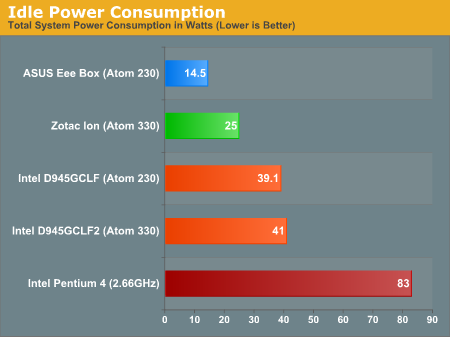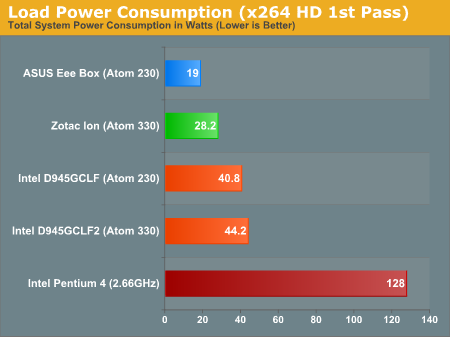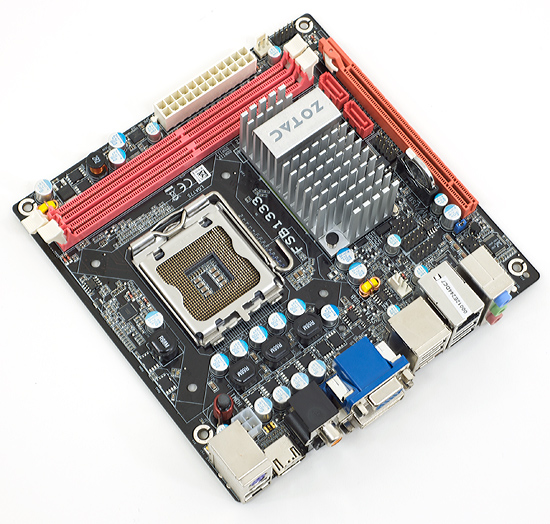Zotac's Ion: The World's First mini-ITX Ion Board
by Anand Lal Shimpi on May 12, 2009 12:00 AM EST- Posted in
- GPUs
Power Consumption
Compared to the Intel Atom boards, the Zotac wins out - it doesn't have to use a bulky desktop power supply which isn't as efficient at these low power draws. Compared to something more similar however, like the Atom 230 based ASUS Eee Box with its own external DC power supply, we see that the Zotac Ion does draw more power than Intel's Atom platform. I'm not sure how much more this could be cut down when used in a netbook/notebook, but that could be a deal breaker for more mobile versions of Ion.


Final Words
What do I think of the world's first mini-ITX Atom Ion motherboard? I like it. Zotac did a good job of delivering pretty much everything I'd want in a board like this, going even further than expected and offering a solution with an external power brick. I don't like the external power option from a long-term replacement standpoint, but I do appreciate its convenience. My only complaint is the price, at $189 it's a bit expensive for the performance you get but I do concede that there are some benefits in the convenience department. All you need to add is memory and some sort of storage and you're good to go, you'll have a system that's easily capable of playing back high definition content (not to mention very power efficient while doing it).
The general application performance of the Zotac Ion isn’t actually any better than the Intel D945GCLF2. It’s when you look at GPU-enabled applications that the Ion holds any real performance benefit. Blu-ray playback or 3D gaming are its real performance strengths; if you plan on doing neither then the platform isn’t very useful.
I did try some CUDA applications on the Zotac Ion board and they were definitely faster than using the CPU alone. While our x264 test managed around 12 fps on the Zotac Ion, using Badaboom I was able to encode at just under 20 fps.
When it comes to the Atom processor, at least on the desktop, there’s simply no reason to opt for the single-core model. Most tasks are so completely CPU bound on Atom that any increase in processing power is instantly noticeable. The Atom 330 ends up being faster than even a 1.6GHz single-core Celeron 420 in many tests, particularly video encoding and 3D rendering, while falling behind in other applications like WinRAR and even our general SYSMark tests. With enough cores, the Atom architecture is efficient in delivering good floating point performance it seems. Branchy integer code however favors the speculative execution engines of more conventional desktop microprocessors. The only reason I see the single-core Atom being of any use is if you're building a cheap file server, but otherwise the Atom 330 is so much faster across the board that it's more than worth it. Hyper-Threading definitely helps the Atom 230, but there's no replacement for another fully functional core. The added power consumption is nothing serious.
If you do need more CPU power, Zotac actually offers an LGA-775 version of the board but it of course requires a standard power supply:

Power consumption on the Zotac Ion is appreciably low, thanks in part to its 90W DC power supply. Compared to ASUS’ Eee Box however, the Ion system does use nearly 50% more power under load.
Everyone seemed to want an Ion based motherboard after NVIDIA first showed off its reference platform. Acer delivered the first Ion system, but it looks like Zotac is delivering what we all wanted from the start. Now it's time to see how people start using these things....










93 Comments
View All Comments
nubie - Tuesday, May 12, 2009 - link
Assuming the price is under $180 for the LGA 775 board that would be my choice.You can passively cool a Celeron 420, 430 or 440 and pick one up for $25-30 on ebay. The Conroe-L will absolutely murder the Atom for any gaming or encoding, and most of them will bump to 1066 without a voltage increase.
The 775 board is $139 with free shipping.
http://www.newegg.com/Product/Product.aspx?Item=N8...">http://www.newegg.com/Product/Product.aspx?Item=N8...
Throw an e5200 or Celeron DualCore at it and just laugh at the Ion platform trying to keep up.
Don't forget the PCI-e 2.0 x16 slot so you can game too if you want.
My choice is pretty clear, forget ION for the desktop unless you really need one of the features (DC power, ultra-low consumption, just can't afford the extra $20-40) the LGA 775 is the better choice for future-proofing an ITX platform. And chances are you have the CPU and heatsink laying around (I know I do.)
If they can get a 32nm Desktop processor at 15-20 watts (for the CPU) instead of that Atom I would love to see it.
strikeback03 - Wednesday, May 13, 2009 - link
I'm not sure I would call anything on LGA 775 future-proofing, as all the processors we are going to see for that socket are now out. So yes performance would be better than Ion, but it would still be a system with almost no room to upgrade.nubie - Thursday, May 14, 2009 - link
I meant future-proofing as in "allowing the platform to remain viable into the foreseeable future." And in comparison with the Atom board it is infinitely future-proof (X16 PCI-e 2.0 and an LGA socket will do that.)You can't argue that a 3.0ghz Quad core won't work adequately for the next 5 years on any conceivable OS, whereas this Atom processor is struggling even now.
Not to mention the PCI-e 2.0 x16 slot, what happens when the 9300 doesn't cut it anymore? The Atom platform has no room for upgrade.
If they cost the same when you outfit the LGA 775 motherboard with a Celeron (and the celeron is much faster), with the option down the road of a dual or quad core and any video card you want, I would say in comparison to the Atom board it is future-proofing.
strikeback03 - Thursday, May 14, 2009 - link
If power consumption is a concern though, you won't ever be using a Penryn quad-core. Due to the memory controller it is highly unlikely any motherboards from the Penryn era will be usable with future processors, so for low power usage an Atom board now and something else low power in a year or two is more likely the way to go.dEad0r - Tuesday, May 12, 2009 - link
Why are there different versions of that platform?Today Computerbase released their review of the "Zotac IONITX-A", which features the same CPU, but offers the faster Nvidia 9400 graphics card onboard.
So all the gaming benchmarks should be way better.
http://www.computerbase.de/artikel/hardware/mainbo...">http://www.computerbase.de/artikel/hard...dia_ion/...
As you can see, for World in Conflict, Doom 3, F.E.A.R. and Company of Heroes are fully playable at 1024x768 1xAA/1xAF, as the ION gives us ~30 fps in those tests.
JarredWalton - Tuesday, May 12, 2009 - link
Don't get too carried away: the 9400 runs at 580/1400MHz core/shader clocks while the 9300 runs at 450/1200MHz core/shader clocks. Assuming games aren't bottlenecked by memory bandwidth, the 9400 is about 20% faster - so it could equal the X800 XT.Those benchmarks you link show the GeForce 9400 as being around six times faster than the 945G chipset, which is quite similar to the results Anand shows in WoW. I'm guessing that the details are set to low or medium in order to get many of those games to 5-6FPS with the GMA 950.
Pirks - Tuesday, May 12, 2009 - link
when you have this: http://www.newegg.com/Product/Product.aspx?Item=N8...">http://www.newegg.com/Product/Product.aspx?Item=N8...sprockkets - Tuesday, May 12, 2009 - link
Because that board is crap compared to the Intel LGA board in the article.It lacks a x16 pci-e slot, wifi isn't built in, needs laptop ram and has no optical or coax audio out. Plus, Linux easily supports PureVideo; no such tech I know of for Ati. While this does feature more SATA ports, I can live without that.
And you rather pay $20 more for that?
Visual - Wednesday, May 13, 2009 - link
dude, the atom mini itx boards also don't have pci-express 16x. intels have a pci just like this amd, the ion one has mini-pci-e which is just 1x and it is ment to be used with the bundled wireless card - it will be quite hard to find other devices for it.where did you get that 16x from?
sprockkets - Thursday, May 14, 2009 - link
Are you capable of looking at the specs yourself of the LGA board in the article?Or, look here: http://www.newegg.com/Product/Product.aspx?Item=N8...">http://www.newegg.com/Product/Product.aspx?Item=N8...
I accept your apology Pirks.